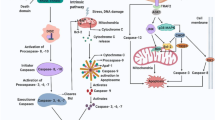Abstract
We present a comparative study of apoptotic and necrotic morphology (light and scanning electron microscopy), induced by well known experimental conditions (photodynamic treatments, etoposide, hydrogen peroxide, freezing-thawing and serum deprivation) on cell cultures. Our results indicate that morphological criteria (apoptotic cell rounding and shrinkage, and appearance of membrane bubbles in early necrosis) allow to distinguish these cell death mechanisms, and also show that, independently of the damaging agents, the necrotic process occurs in a characteristic sequence (coalescence of membrane bubbles in a single big one that detaches from cells remaining on the substrate).
Similar content being viewed by others
References
Villanueva A, Domínguez V, Polo S, et al. Photokilling mechanisms induced by zinc(II)-phthalocyanine on cultured tumor cells. Oncol Res 1999; 11: 447–453.
Villanueva A, Durantini EN, Stockert JC, et al. Photokilling of cultured tumour cells by the porphyrin derivative CF3. Anticancer Drug Des 2001; 16: 279–290.
Joza N, Susin SA, Daugas E, et al. Essential role of the mitochondrial apoptosis-inducing factor in programmed cell death. Nature 2001; 410: 549–554.
Colombaioni L, Frago LM, Varela-Nieto I, Pesi R, García-Gil M. Serum deprivation increases ceramide levels and induces apoptosis in undifferentiated HN9.10e cells. Neurochem Int 2002; 40: 327–336.
Negri C, Bernardi R, Braghetti A, Riccotti GC, Scovassi AI. The effect of the chemoterapeutic drug VP-16 on poly(ADP-ribosylation) in apoptotic HeLa cells. Carcinogenesis 1993; 14: 2559–2564.
Kressel M, Groscurth P. Distinction of apoptotic and necrotic cell death by in situ labelling of fragmented DNA. Cell Tissue Res 1994; 278: 549–556.
Didenko VV, Ngo H, Baskin DS. Early necrotic DNA degradation: Presence of blunt-ended DNA breaks, 3′ and 5′ overhangs in apoptosis, but only 5′ overhangs in early necrosis. Am J Pathol 2003; 162: 1571–1578.
Palomba L, Sestili P, Columbaro M, Falcieri E, Cantoni O. Apoptosis and necrosis following exposure of U937 cells to increasing concentrations of hydrogen peroxide: The effect of the poly(ADP-ribose)polymerase inhibitor 3-aminobenzamide. Biochem Pharmacol 1999; 58: 1743–1750.
McKeague AL, Wilson DJ, Nelson J. Staurosporine-induced apoptosis and hydrogen peroxide-induced necrosis in two human breast cell lines. Br J Cancer 2003; 88: 125–131.
Stadelmann C, Lassmann H. Detection of apoptosis in tissue sections. Cell Tissue Res 2000; 301: 19–31.
Lecoeur H, Prévost MC, Gougeon ML. Oncosis is associated with exposure of phosphatidylserine residues on the outside layer of the plasma membrane: A reconsideration of the specificity of the annexin V/propidium iodide assay. Cytometry 2001; 44: 65–72.
Darzynkiewicz Z, Juan G, Li X, Gorczyca W, Murakami T, Traganos F. Cytometry in cell necrobiology: Analysis of apoptosis and accidental cell death (necrosis). Cytometry 1997; 27: 1–20.
Frankfurt OS, Krishan A. Identification of apoptotic cells by formamide-induced DNA denaturation in condensed chromatin. J Histochem Cytochem 2001; 49: 369–378.
Stolzenberg I, Wulf S, Mannherz HG, Paddenberg R. Different sublines of Jurkat cells respond with varying susceptibility of internucleosomal DNA degradation to different mediators of apoptosis. Cell Tissue Res 2000; 301: 273–278.
Herrmann M, Lorenz HM, Voll R, Grunke M, Woith W, Kalden JR. A rapid and simple method for the isolation of apoptotic DNA fragments. Nucleic Acids Res 1994; 22: 5506-5507.
Cohen GM, Sun XM, Snowden RT, Dinsdale D, Skilleter DN. Key morphological features of apoptosis may occur in the absence of internucleosomal DNA fragmentation. Biochem J 1992; 286: 331–334.
Collins RJ, Harmon BV, Gobé GC, Kerr JFR. Internucleosomal DNA cleavage should not be the sole criterion for identifying apoptosis. Int J Radiat Biol 1992; 61: 451–453.
Zhang Y, Wu LJ, Tashiro S, Onodera S, Ikejima T. Evodiamine induces tumor cell death through different pathways: Apoptosis and necrosis. Acta Pharmacol Sin 2004; 25: 83–89.
Estacion M, Schilling WP. Blockade of maitotoxin-induced oncotic cell death reveals zeiosis. BMC Physiol 2002; 2: 2.
Renvoize C, Biola A, Pallardy M, Breard J. Apoptosis: Identification of dying cells. Cell Biol Toxicol 1998; 14: 111–120.
Formigli L, Papucci L, Tani A, et al. Aponecrosis: Morphological and biochemical exploration of a syncretic process of cell death sharing apoptosis and necrosis. J Cell Physiol 2000; 182: 41–49.
Collins JA, Schandl CA, Young KK, Vesely J, Willingham MC. Major DNA fragmentation is a late event in apoptosis. J Histochem Cytochem 1997; 45: 923–934.
Herman B, Nieminen AL, Gores GJ, Lemasters JJ. Irreversible injury in anoxic hepatocytes precipitated by an abrupt increase in plasma membrane permeability. FASEB J 1988; 2: 146–151.
Nieminen AL. Apoptosis and necrosis in health and disease: Role of mitochondria. Int Rev Cytol 2003; 224: 29–55.
Author information
Authors and Affiliations
Corresponding author
Rights and permissions
About this article
Cite this article
Rello, S., Stockert, J.C., Moreno, V. et al. Morphological criteria to distinguish cell death induced by apoptotic and necrotic treatments. Apoptosis 10, 201–208 (2005). https://doi.org/10.1007/s10495-005-6075-6
Issue Date:
DOI: https://doi.org/10.1007/s10495-005-6075-6




